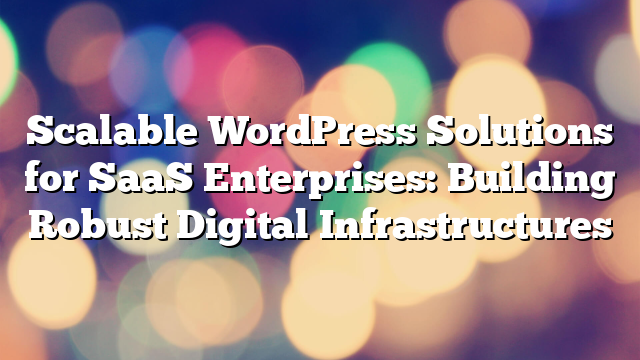How Headless WordPress Drives Innovation for Enterprise Websites
26.11.2024

As enterprise websites grow in complexity, traditional content management systems (CMS) often struggle to meet the demands of modern digital experiences. Enter Headless WordPress, a cutting-edge solution that separates the back-end content management from the front-end presentation. This decoupled approach empowers enterprises to create faster, more scalable, and innovative websites tailored to their specific needs. In this article, we’ll explore how Headless WordPress is revolutionizing enterprise website development and why it’s a game-changer for businesses aiming to stay ahead in the digital landscape.
What is Headless WordPress?
Headless WordPress is a decoupled CMS architecture where the WordPress back-end is used solely for content management, while the front-end is built with modern frameworks like React, Vue.js, or Angular. Communication between the two layers happens via APIs, such as the WordPress REST API or GraphQL. This separation allows developers to create dynamic, highly customized front-end experiences while leveraging the robust CMS capabilities of WordPress.
Why Enterprises Are Embracing Headless WordPress
1. Unmatched Performance
Speed is a critical factor for enterprise websites, especially those handling high traffic volumes. With Headless WordPress, the front-end is powered by lightweight, modern JavaScript frameworks, enabling faster load times and better performance compared to traditional WordPress setups.
2. Omnichannel Content Delivery
Enterprises often need to deliver content across multiple platforms, including websites, mobile apps, IoT devices, and digital kiosks. Headless WordPress facilitates omnichannel content delivery by serving as a centralized hub for content, which can then be distributed to any device or platform via APIs.
3. Scalability and Flexibility
As enterprises grow, their digital needs become more complex. Headless WordPress offers unparalleled scalability, allowing businesses to integrate third-party tools, microservices, and advanced front-end technologies. This flexibility ensures that enterprise websites can evolve alongside their goals.
4. Enhanced Security
By decoupling the front-end from the back-end, Headless WordPress reduces the attack surface for hackers. Since the WordPress admin panel is hidden behind the API, it becomes harder for malicious actors to exploit vulnerabilities.
5. Developer Freedom
Traditional WordPress themes and plugins can be limiting for enterprise-level customization. Headless WordPress gives developers the freedom to build fully custom front-ends using their preferred frameworks and tools, enabling unique and innovative digital experiences.
Key Features of Headless WordPress
1. API-Driven Architecture
Headless WordPress relies on APIs like the REST API or GraphQL to fetch and display content. This enables seamless integration with external systems, such as CRMs, e-commerce platforms, or marketing automation tools.
2. Multi-Platform Support
With Headless WordPress, content can be reused and displayed across various platforms, ensuring a consistent user experience. Enterprises can maintain a single content repository for web, mobile, and other digital channels.
3. Improved Front-End Performance
Using modern JavaScript frameworks for the front-end allows developers to implement features like lazy loading, server-side rendering, and prefetching, resulting in a faster and more responsive user experience.
Challenges of Headless WordPress
1. Higher Development Costs
Building a Headless WordPress website requires advanced technical expertise and resources. Enterprises must invest in skilled developers and ongoing maintenance to fully realize its benefits.
2. Learning Curve
Transitioning to a headless architecture can be challenging for teams unfamiliar with decoupled systems. Training and documentation are essential to ensure smooth adoption.
3. Increased Complexity
Managing a headless setup involves coordinating between the back-end and front-end, which can be more complex than a traditional WordPress site. Enterprises need robust workflows and tools to manage this complexity effectively.
Best Practices for Implementing Headless WordPress
1. Plan Your Architecture
Define the scope and requirements of your headless setup before development begins. Identify the platforms and devices where your content will be delivered and choose the right front-end frameworks accordingly.
2. Optimize APIs
Ensure that your APIs are well-structured, secure, and performant. Use caching and pagination to minimize latency and improve the speed of API calls.
3. Use Server-Side Rendering (SSR)
Implement server-side rendering to enhance SEO and improve page load speeds. Frameworks like Next.js make it easy to integrate SSR into a headless WordPress setup.
4. Monitor and Test Regularly
Regularly monitor the performance and security of your headless system. Use tools like Lighthouse and OWASP to identify and address potential issues.
5. Choose the Right Hosting Solution
Select a hosting provider optimized for headless architectures. Platforms like Vercel, Netlify, or AWS offer robust support for modern front-end frameworks and WordPress back-ends.
Conclusion
Headless WordPress represents the future of enterprise website development, enabling businesses to innovate and scale like never before. By decoupling content management from front-end presentation, enterprises can deliver fast, engaging, and personalized digital experiences across multiple platforms. While the initial setup may require investment and expertise, the long-term benefits make Headless WordPress an invaluable tool for enterprises aiming to lead in today’s digital-first world.
Looking to transform your enterprise website with Headless WordPress? Contact AllWebDev today to explore how we can help you harness the power of this cutting-edge technology.



